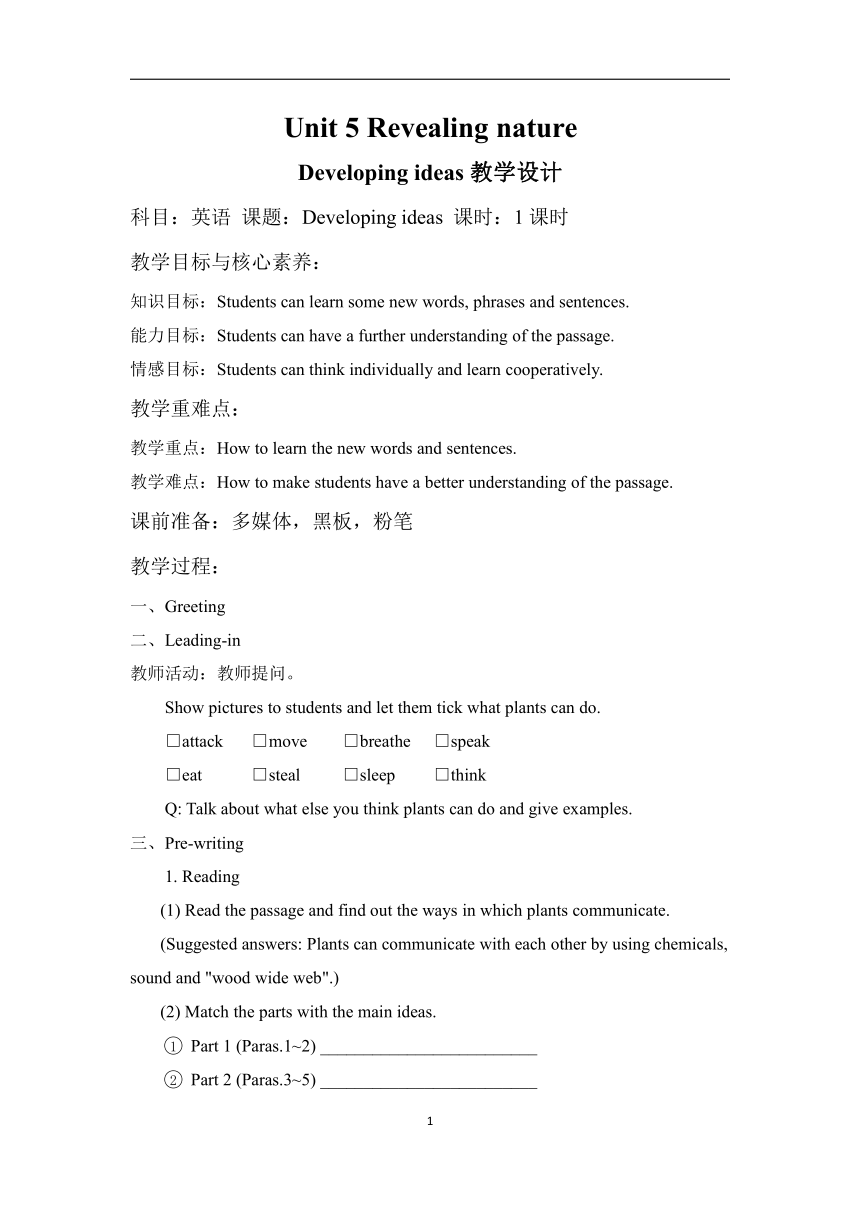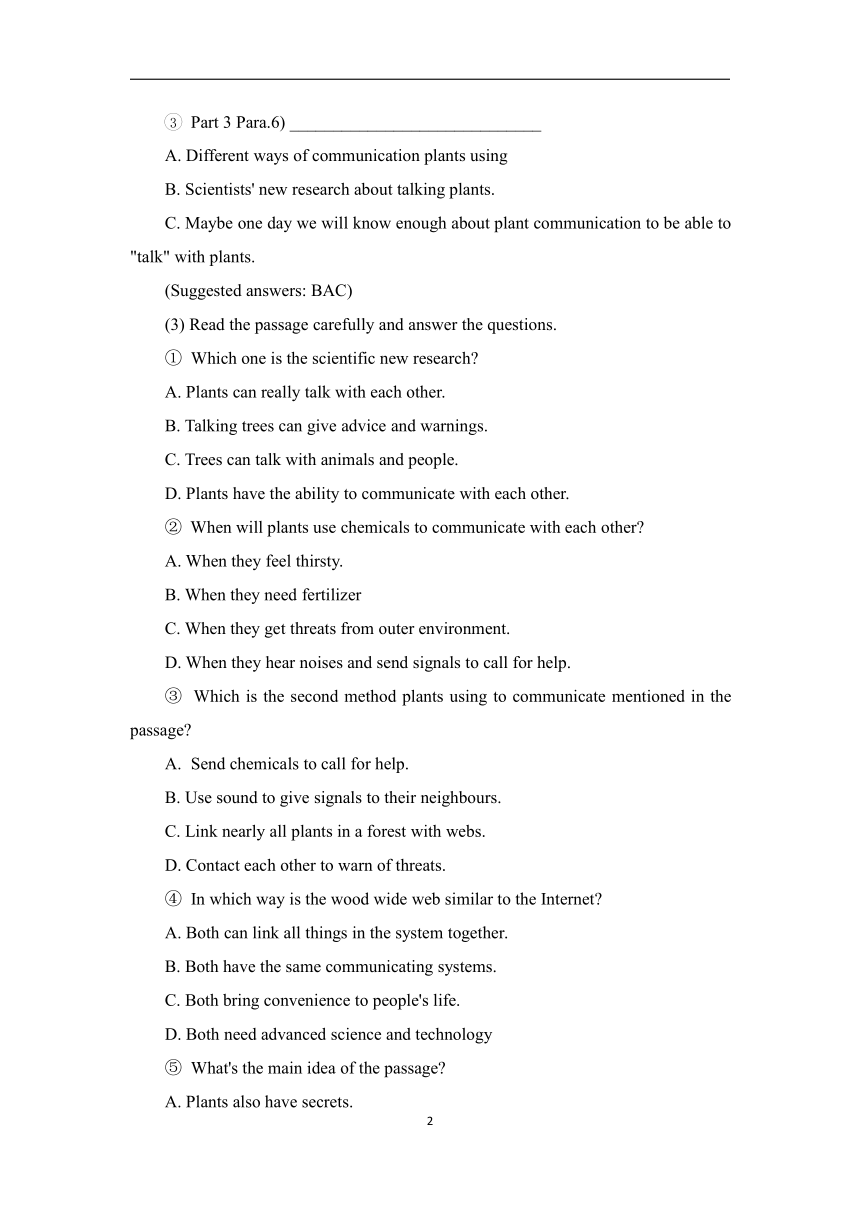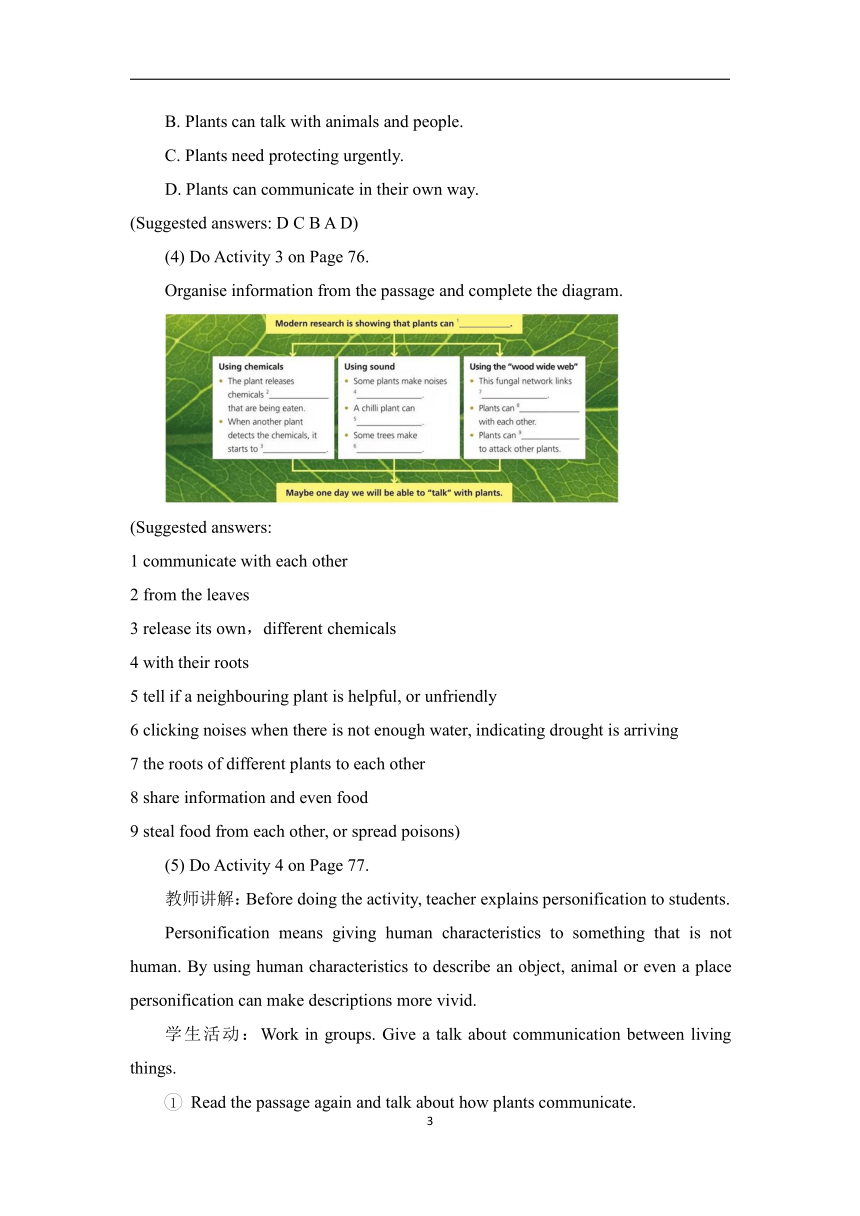外研版(2019)选择性必修 第一册Unit 5 Revealing nature Developing ideas 教案
文档属性
| 名称 | 外研版(2019)选择性必修 第一册Unit 5 Revealing nature Developing ideas 教案 |

|
|
| 格式 | docx | ||
| 文件大小 | 860.6KB | ||
| 资源类型 | 教案 | ||
| 版本资源 | 外研版(2019) | ||
| 科目 | 英语 | ||
| 更新时间 | 2023-11-29 11:19:17 | ||
图片预览



文档简介
Unit 5 Revealing nature
Developing ideas教学设计
科目:英语 课题:Developing ideas 课时:1课时
教学目标与核心素养:
知识目标:Students can learn some new words, phrases and sentences.
能力目标:Students can have a further understanding of the passage.
情感目标:Students can think individually and learn cooperatively.
教学重难点:
教学重点:How to learn the new words and sentences.
教学难点:How to make students have a better understanding of the passage.
课前准备:多媒体,黑板,粉笔
教学过程:
Greeting
Leading-in
教师活动:教师提问。
Show pictures to students and let them tick what plants can do.
□attack □move □breathe □speak
□eat □steal □sleep □think
Q: Talk about what else you think plants can do and give examples.
Pre-writing
1. Reading
(1) Read the passage and find out the ways in which plants communicate.
(Suggested answers: Plants can communicate with each other by using chemicals, sound and "wood wide web".)
(2) Match the parts with the main ideas.
Part 1 (Paras.1~2) _________________________
Part 2 (Paras.3~5) _________________________
Part 3 Para.6) _____________________________
A. Different ways of communication plants using
B. Scientists' new research about talking plants.
C. Maybe one day we will know enough about plant communication to be able to "talk" with plants.
(Suggested answers: BAC)
(3) Read the passage carefully and answer the questions.
① Which one is the scientific new research
A. Plants can really talk with each other.
B. Talking trees can give advice and warnings.
C. Trees can talk with animals and people.
D. Plants have the ability to communicate with each other.
② When will plants use chemicals to communicate with each other
A. When they feel thirsty.
B. When they need fertilizer
C. When they get threats from outer environment.
D. When they hear noises and send signals to call for help.
③ Which is the second method plants using to communicate mentioned in the passage
Send chemicals to call for help.
B. Use sound to give signals to their neighbours.
C. Link nearly all plants in a forest with webs.
D. Contact each other to warn of threats.
④ In which way is the wood wide web similar to the Internet
A. Both can link all things in the system together.
B. Both have the same communicating systems.
C. Both bring convenience to people's life.
D. Both need advanced science and technology
⑤ What's the main idea of the passage
A. Plants also have secrets.
B. Plants can talk with animals and people.
C. Plants need protecting urgently.
D. Plants can communicate in their own way.
(Suggested answers: D C B A D)
(4) Do Activity 3 on Page 76.
Organise information from the passage and complete the diagram.
(Suggested answers:
1 communicate with each other
2 from the leaves
3 release its own,different chemicals
4 with their roots
5 tell if a neighbouring plant is helpful, or unfriendly
6 clicking noises when there is not enough water, indicating drought is arriving
7 the roots of different plants to each other
8 share information and even food
9 steal food from each other, or spread poisons)
(5) Do Activity 4 on Page 77.
教师讲解:Before doing the activity, teacher explains personification to students.
Personification means giving human characteristics to something that is not human. By using human characteristics to describe an object, animal or even a place personification can make descriptions more vivid.
学生活动:Work in groups. Give a talk about communication between living things.
Read the passage again and talk about how plants communicate.
Think about and discuss the following ways of communication in the animal world.
Bees "dance" to signal to other bees that they have found food.
Ants communicate with each other through touch, chemical signals,moving their bodies and even using their legs to make sounds.
What other ways can you think of
Organise your ideas following the steps below.
Begin with what living things you have chosen to talk about.
Explain how they communicate and give examples.
Conclude by explaining what we have learnt from their behaviour.
④ Give a talk to the class about communication between living things.
四、While-writing
1. Do Activity 5 on Page 78.
Read the observational journal and answer the questions.
How were the daffodil bulbs planted
In what environment did the leaves grow
What do the flowers look like
(Suggested answers:
·They were planted side by side in soil, with the pointed ends facing up.
·The leaves grew in a sunny, but cool place.
·The flowers are yellow and white, and shaped like trumpets.)
2. Do Activity 6 on Page 79.
(1) Work in pairs. Look at the pictures and talk about how the sunflower grows.
(2) Write your observational journal about the sunflower.
3. 教师讲解:写作思路
(1) 一审:体裁、主题和结构
体裁:日志
主题:观察植物的生长过程
结构:三段(三个阶段植物生长变化)
(2) 二定:人称和时态
人称:第一人称为主、第三人称为辅
时态:一般现在时
(3) 三明确
明确写作要点:
种下种子;
种子发芽、长出叶子等过程;
自己的心情和期盼。
(4) 提分词汇:grow up; as soon as; look forward to; share the joy
五、Post-writing
学生活动:Work in pairs. Make improvements to each other's passages and share them with the class.
教师活动:邀请几位同学展示他们的作品。
An observational journal about the sunflower
1 June
Covered with 1-2 cm of moist soil, the sunflower seed takes a few days to come up after being planted. Water has been added regularly and the hard seed coat softens in the damp soil to allow the first root to pierce downwards and the first leaves to push to the soil surface.
6 July
The root continues to grow downwards. The single stem grows hollow and smooth, revealing large spade shaped leaves from the growing tip. Gradually, the plant's growing tip reveals the first hints of development of the flower bud. The plant stem becomes more woody.
26 July
About three weeks after the flower bud first becomes visible at the tip of the sunflower stem, it enlarges and begins to reveal a flattened disc. Over the course of one week, the yellow ray florets, the disc florets bloom across the core of the sunflower blossom. It is yellow, looking beautiful.
学生活动:Presenting ideas.
①Activity 1. Work in groups. Look at the information about the nature documentaries and answer the questions.
1 Can you guess what secrets of nature are revealed in these documentaries
2 What other nature documentaries have you watched Which one do you like most Give your reasons.
②Activity 2. Choose one nature documentary you like and complete the notes.
③Practise presenting information about your documentary. Consider the following:
1 the structure of your presentation
2 useful words, expressions and structures
④Give your presentation to the class.
六、Summary
1. 掌握本课时重点词汇:burst、assign、opponent、comeback、defeat、nerve、seize、cooperation、teamwork、intense 和短语 burst onto、pay off、come true、once again、contribute to、 be identified as, thanks to、 ups and downs、make the greatest impression on 以及重要型, 并能熟练运用。
2. 掌握场景描写的特征和方法,运用本单元所学语言知识,通过观察,学会细致地描述场景并根据课后要求描述一段体育场景。
3. 女排精神曾被运动员们视为刻苦奋斗的标杆和座右铭,鼓舞着他们的士气和热情。鼓励学生在学习中发扬女排的刻苦钻研、勇往直前的精神,更上一层楼。
七、Homework
Review the language points learned in the class.
2
Developing ideas教学设计
科目:英语 课题:Developing ideas 课时:1课时
教学目标与核心素养:
知识目标:Students can learn some new words, phrases and sentences.
能力目标:Students can have a further understanding of the passage.
情感目标:Students can think individually and learn cooperatively.
教学重难点:
教学重点:How to learn the new words and sentences.
教学难点:How to make students have a better understanding of the passage.
课前准备:多媒体,黑板,粉笔
教学过程:
Greeting
Leading-in
教师活动:教师提问。
Show pictures to students and let them tick what plants can do.
□attack □move □breathe □speak
□eat □steal □sleep □think
Q: Talk about what else you think plants can do and give examples.
Pre-writing
1. Reading
(1) Read the passage and find out the ways in which plants communicate.
(Suggested answers: Plants can communicate with each other by using chemicals, sound and "wood wide web".)
(2) Match the parts with the main ideas.
Part 1 (Paras.1~2) _________________________
Part 2 (Paras.3~5) _________________________
Part 3 Para.6) _____________________________
A. Different ways of communication plants using
B. Scientists' new research about talking plants.
C. Maybe one day we will know enough about plant communication to be able to "talk" with plants.
(Suggested answers: BAC)
(3) Read the passage carefully and answer the questions.
① Which one is the scientific new research
A. Plants can really talk with each other.
B. Talking trees can give advice and warnings.
C. Trees can talk with animals and people.
D. Plants have the ability to communicate with each other.
② When will plants use chemicals to communicate with each other
A. When they feel thirsty.
B. When they need fertilizer
C. When they get threats from outer environment.
D. When they hear noises and send signals to call for help.
③ Which is the second method plants using to communicate mentioned in the passage
Send chemicals to call for help.
B. Use sound to give signals to their neighbours.
C. Link nearly all plants in a forest with webs.
D. Contact each other to warn of threats.
④ In which way is the wood wide web similar to the Internet
A. Both can link all things in the system together.
B. Both have the same communicating systems.
C. Both bring convenience to people's life.
D. Both need advanced science and technology
⑤ What's the main idea of the passage
A. Plants also have secrets.
B. Plants can talk with animals and people.
C. Plants need protecting urgently.
D. Plants can communicate in their own way.
(Suggested answers: D C B A D)
(4) Do Activity 3 on Page 76.
Organise information from the passage and complete the diagram.
(Suggested answers:
1 communicate with each other
2 from the leaves
3 release its own,different chemicals
4 with their roots
5 tell if a neighbouring plant is helpful, or unfriendly
6 clicking noises when there is not enough water, indicating drought is arriving
7 the roots of different plants to each other
8 share information and even food
9 steal food from each other, or spread poisons)
(5) Do Activity 4 on Page 77.
教师讲解:Before doing the activity, teacher explains personification to students.
Personification means giving human characteristics to something that is not human. By using human characteristics to describe an object, animal or even a place personification can make descriptions more vivid.
学生活动:Work in groups. Give a talk about communication between living things.
Read the passage again and talk about how plants communicate.
Think about and discuss the following ways of communication in the animal world.
Bees "dance" to signal to other bees that they have found food.
Ants communicate with each other through touch, chemical signals,moving their bodies and even using their legs to make sounds.
What other ways can you think of
Organise your ideas following the steps below.
Begin with what living things you have chosen to talk about.
Explain how they communicate and give examples.
Conclude by explaining what we have learnt from their behaviour.
④ Give a talk to the class about communication between living things.
四、While-writing
1. Do Activity 5 on Page 78.
Read the observational journal and answer the questions.
How were the daffodil bulbs planted
In what environment did the leaves grow
What do the flowers look like
(Suggested answers:
·They were planted side by side in soil, with the pointed ends facing up.
·The leaves grew in a sunny, but cool place.
·The flowers are yellow and white, and shaped like trumpets.)
2. Do Activity 6 on Page 79.
(1) Work in pairs. Look at the pictures and talk about how the sunflower grows.
(2) Write your observational journal about the sunflower.
3. 教师讲解:写作思路
(1) 一审:体裁、主题和结构
体裁:日志
主题:观察植物的生长过程
结构:三段(三个阶段植物生长变化)
(2) 二定:人称和时态
人称:第一人称为主、第三人称为辅
时态:一般现在时
(3) 三明确
明确写作要点:
种下种子;
种子发芽、长出叶子等过程;
自己的心情和期盼。
(4) 提分词汇:grow up; as soon as; look forward to; share the joy
五、Post-writing
学生活动:Work in pairs. Make improvements to each other's passages and share them with the class.
教师活动:邀请几位同学展示他们的作品。
An observational journal about the sunflower
1 June
Covered with 1-2 cm of moist soil, the sunflower seed takes a few days to come up after being planted. Water has been added regularly and the hard seed coat softens in the damp soil to allow the first root to pierce downwards and the first leaves to push to the soil surface.
6 July
The root continues to grow downwards. The single stem grows hollow and smooth, revealing large spade shaped leaves from the growing tip. Gradually, the plant's growing tip reveals the first hints of development of the flower bud. The plant stem becomes more woody.
26 July
About three weeks after the flower bud first becomes visible at the tip of the sunflower stem, it enlarges and begins to reveal a flattened disc. Over the course of one week, the yellow ray florets, the disc florets bloom across the core of the sunflower blossom. It is yellow, looking beautiful.
学生活动:Presenting ideas.
①Activity 1. Work in groups. Look at the information about the nature documentaries and answer the questions.
1 Can you guess what secrets of nature are revealed in these documentaries
2 What other nature documentaries have you watched Which one do you like most Give your reasons.
②Activity 2. Choose one nature documentary you like and complete the notes.
③Practise presenting information about your documentary. Consider the following:
1 the structure of your presentation
2 useful words, expressions and structures
④Give your presentation to the class.
六、Summary
1. 掌握本课时重点词汇:burst、assign、opponent、comeback、defeat、nerve、seize、cooperation、teamwork、intense 和短语 burst onto、pay off、come true、once again、contribute to、 be identified as, thanks to、 ups and downs、make the greatest impression on 以及重要型, 并能熟练运用。
2. 掌握场景描写的特征和方法,运用本单元所学语言知识,通过观察,学会细致地描述场景并根据课后要求描述一段体育场景。
3. 女排精神曾被运动员们视为刻苦奋斗的标杆和座右铭,鼓舞着他们的士气和热情。鼓励学生在学习中发扬女排的刻苦钻研、勇往直前的精神,更上一层楼。
七、Homework
Review the language points learned in the class.
2
